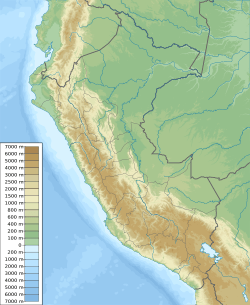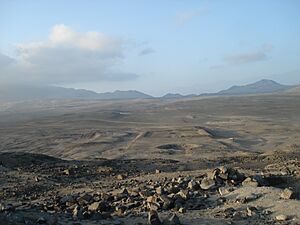Las Haldas facts for kids
| Alternative name | Las Aldas |
|---|---|
| Location | Ancash, Peru |
| Coordinates | 9°42′09″S 78°17′50″W / 9.70250°S 78.29722°W |
| Type | Settlement |
| History | |
| Founded | c. 2200 BCE |
| Abandoned | c. 300 BCE |
| Cultures | Casma/Sechin culture |
| Site notes | |
| Condition | In ruins |
Las Haldas (also called Las Aldas) is a very old archaeological site in Peru. It was built long before pottery was common, and also during the time when people started using pottery. This period was from about 2200 BCE to 300 BCE.
Las Haldas is on the Pacific coast. It's about 300 kilometers (186 miles) north of Lima. It's also about 20 kilometers (12 miles) south of the Casma River valley. The Casma valley is famous for many old ruins from the Casma–Sechin culture.
For most of its history, Las Haldas was a coastal town. It lived alongside farming communities in the Casma River Valley. What makes Las Haldas special is how old and big it is. It's one of the earliest sites from the pottery period. The people there mostly ate food from the ocean. They didn't do much farming themselves. Also, it was built far from any fresh water source.
Las Haldas is in an area where some of the oldest civilizations in the Americas lived. The Casma valley sites are just north of it. The Caral-Supe civilization is about 60 kilometers (37 miles) to the south.
Contents
Discovering Las Haldas
Archaeologists found Las Haldas in 1956. Many experts have studied it since then. It wasn't found earlier because of its unusual location. It's far from fresh water and land that could be farmed.
Las Haldas sits on a raised area near the rocky ocean coast. It's about 37 meters (120 feet) above sea level. The land around Las Haldas is very dry. There are almost no plants growing there. This coastal area gets less than 25 millimeters (1 inch) of rain each year.
Layout of the Ruins
The ruins of Las Haldas cover about 40 hectares (99 acres). The main part is shaped like a "U" and is 370 meters (400 yards) long. It has a large mound at one end. There are also four slightly raised plazas, which are like open squares. The biggest plaza has a circular court.
Around this main area, there are 18 smaller mounds. Each of these has its own plaza. One of them also has a circular court. People's homes were built on either side of these large, important buildings.
Las Haldas was quite separate from other old sites. The closest ones were farming villages in the Casma River valley. These were about 12 kilometers (7.5 miles) to the north. The Casma valley was also the closest place to get fresh water.
People from Las Haldas likely traded seafood with the Casma River settlements. In return, they got farm products. Foods found at Las Haldas include cotton, beans (like lima beans), potatoes, chile peppers, and lucuma. Lucuma is a tropical fruit still popular in Peru today. All these foods probably came from the Casma River valley. Interestingly, Maize (corn) has not been found at Las Haldas. Even though it was grown in Peru at that time.
When Las Haldas Was Important
Most of the buildings at Las Haldas were built between 1800 BCE and 1000 BCE. This is called the Initial Ceramic Period. However, people lived at the site even earlier, from 3000 BCE to 1800 BCE. This was the Late Pre-Ceramic Period. They also continued to live there until about 200 BCE.
Most of the big construction happened in two main times. The first started around 2000 BCE and lasted for 300 to 400 years. The second, shorter period began around 1400 BCE. This was when Las Haldas was at its most important. The buildings from this second period seem to have been copied from the Sechin Alto complex in the Casma River valley. During this time, Las Haldas's building style, and maybe its power, spread north. It even reached Sechin Alto and other coastal towns nearby.
After 1000 BCE, people slowly left Las Haldas. Farming with irrigation (bringing water to crops) became more important. Because of this, coastal settlements became smaller. They became less important than the farming communities in the river valleys.
The Maritime Theory
For a long time, experts believed that civilizations only grew because of farming. Especially farming of grains like wheat or corn. They thought that having extra food from farming was key. It helped more people live in one place and created complex societies.
But in the 1970s, an anthropologist named Michael E. Moseley disagreed. He suggested that the first civilizations in Peru didn't rely on farming. Instead, they used the rich ocean resources along the Peruvian coast. Sites like Las Haldas, which did little or no farming, support his idea. Las Haldas seems to be older than many nearby farming sites. This also supports Moseley's theory.
Newer studies and dating of other sites, like Sechin Bajo, have made some people question Moseley's idea. However, in 2004, Moseley still believed that "Peruvian fishermen can be credited for creating the earliest civilizations in the Americas."
The Mystery of Water
It seems strange that people would build a settlement at Las Haldas. It was so far from any source of drinking water. Some experts thought there must have been water wells nearby.
However, a husband and wife team, the Pozorskis, disagreed. They said that many early fishing villages were built far from rivers. This is because fish and shellfish are more plentiful away from the fresh water near river mouths. They also argued that people wouldn't need much drinking water. The temperatures were mild, and seafood contains a lot of water. They believed it was possible for the people of Las Haldas to carry drinking water from the Casma Valley.
See also
 In Spanish: Las Haldas para niños
In Spanish: Las Haldas para niños



